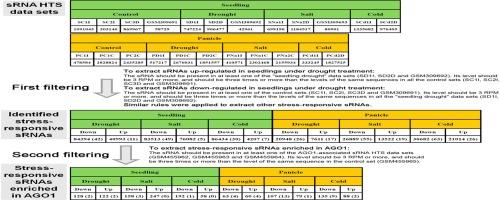Construction of regulatory networks mediated by small RNAs responsive to abiotic stresses in rice (Oryza sativa) |
| |
| Affiliation: | 1. College of Bioscience and Biotechnology, Hunan Agricultural University, Changsha, Hunan 410128, PR China;2. College of Life and Environmental Sciences, Hangzhou Normal University, Hangzhou 310036, PR China;1. School of Chemistry and Chemical Engineering, Guangxi University, Nanning 530004, China;2. China Key Laboratory of Ministry of Education for Water Quality Security and Protection in Pearl River Delta, School of Chemistry & Chemical Engineering, Guangzhou University, Guangzhou 510006, China;3. Key laboratory of Nonferrous Metal and New Processing Technology of Materials (Ministry of Education), Guangxi University, Nanning 530004, China;1. State Key Laboratory of Cotton Biology, State Key Laboratory of Crop Stress Adaptation and Improvement, School of Life Sciences, Henan University, 85 Minglun Street, Kaifeng, 475001, China;2. College of Life Sciences, Shanghai Normal University, Guilin Road 100, Shanghai, 200234, China;1. State Key Laboratory of Crop Genetics and Germplasm Enhancement, Ministry of Science and Technology/College of Horticulture, Nanjing Agricultural University, Nanjing 210095, P.R. China;2. Agriculture Committee of Feixi County, Hefei 230001, P.R. China |
| |
| Abstract: | 
Plants have evolved exquisite molecular mechanisms to adapt to diverse abiotic stresses. MicroRNAs play an important role in stress response in plants. However, whether the other small RNAs (sRNAs) possess stress-related roles remains elusive. In this study, thousands of sRNAs responsive to cold, drought and salt stresses were identified in rice seedlings and panicles by using high-throughput sequencing data. These sRNAs were classified into 12 categories, including “Panicle_Cold_Down”, “Panicle_Cold_Up”, “Panicle_Drought_Down”, “Panicle_Drought_Up”, “Panicle_Salt_Down”, “Panicle_Salt_Up”, “Seedling_Cold_Down”, “Seedling_Cold_Up”, “Seedling_Drought_Down”, “Seedling_Drought_Up”, “Seedling_Salt_Down” and “Seedling_Salt_Up”. The stress-responsive sRNAs enriched in Argonaute 1 were extracted for target prediction and degradome sequencing data-based validation, which enabled network construction. Within certain subnetworks, some target genes were further supported by microarray data. Literature mining indicated that certain targets were potentially involved in stress response. These results demonstrate that the established networks are biologically meaningful. We discovered that in some cases, one sRNA sequence could be assigned to two or more categories. Moreover, within certain target-centered subnetworks, one transcript was regulated by several stress-responsive sRNAs assigned to different categories. It implies that these subnetworks are potentially implicated in stress signal crosstalk. Together, our results could advance the current understanding of the biological role of plant sRNAs in stress signaling. |
| |
| Keywords: | Abiotic stress Argonaute 1 (AGO1) Degradome High-throughput sequencing (HTS) Network Rice small RNA (sRNA) Signal interaction |
| 本文献已被 ScienceDirect 等数据库收录! |
|

